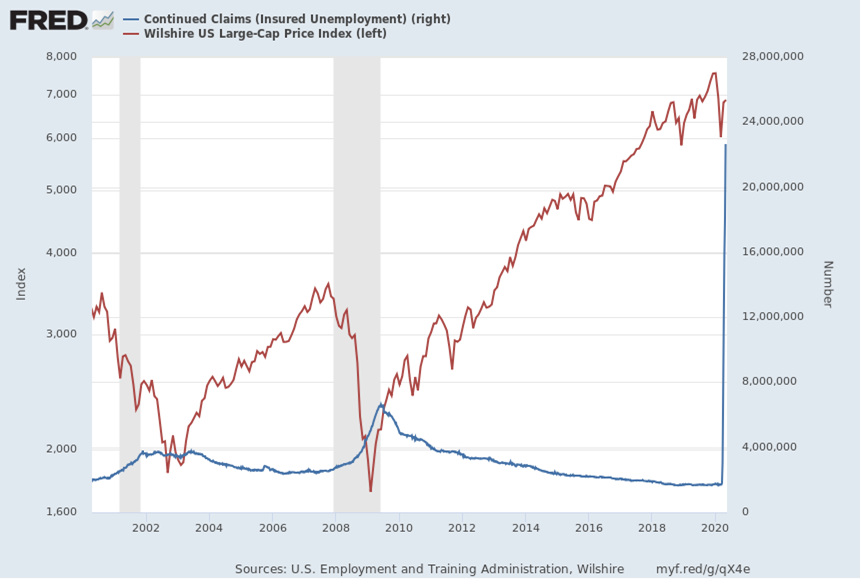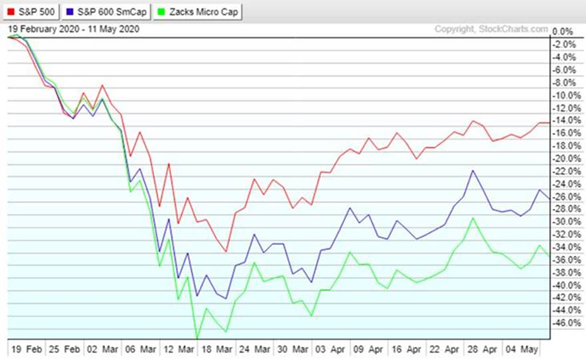One-Month Bear Market?
The historical duration of a bear market averages 22 months. Our current bear market peak was on February 19th and its lowest level (so far) was on March 18th. Since March 18th, the S&P 500 has soared 22% (as of May 11th). While some market pundits seem to believe that the bear is over, others such as David Tepper (click here for his comments today on CNBC) believe the overvaluation of the market is a warning that we should be wary and that the worst is not over yet. His comments are rooted in fundamental economic sense and we agree with his thoughts. Let’s step back in time and take a look at our update from 13 months ago…. And, given the current conditions, the overvaluation can only grow unless there is a market pullback to align with a sensible P/E (price-to-earnings) ratio.
And in other fun news: It seems the S&P 500 has diverged from mainstream America as, overall, the index has grown while Unemployment Insurance claims have soared. Consider this, the S&P 500 is down 13.5% (as of 5/11/20) from its all-time high in the first quarter of this year—a mild correction—while 22,647,000 Americans have filed for Unemployment Insurance. As shown in the chart below, large cap stocks have risen sharply in tandem with unemployment claims. Go figure??

Let’s look at this from a historical view:
- Dot Com Recession, Nov 2001 – 3,790,000 Unemployment Claims
- Financial Crisis, May 2009 – 6,635,000 Unemployment Claims
- COVID-19, April 2020 – 22,647,000 Unemployment Claims*
*And, according to comments from Treasury Secretary Mnuchin, “the reported numbers are probably going to get worse before they get better.”
Who Does the Lifeboat Save?
The Fed has done a good job of reacting quickly, bringing much needed liquidity to the market and propping the large cap stock market. My question is, can this top-heavy approach help everyday Americans as much as it does Bill Gates, Jeff Bezos, Mark Zuckerberg or Tim Cook? I ask this because Alphabet, Amazon, Apple, Facebook and Microsoft now make up a fifth of the S&P 500 index’s value. For the Nasdaq Index, the top 10 stocks (which include Apple, Amazon and Microsoft) make up 44% of all its value—there are 2,700 stocks in the Nasdaq Index.
 The Fed is lifting the large boats and hoping the water will rise. While the S&P 500 is in a loss range of a mild correction, U.S. Small Caps are still down 25.5% and U.S. Micro Caps are down 34.7% (Reuters Data as of 5/11/20, S&P 600 Small Cap Index, Zacks Micro Cap Index).
The Fed is lifting the large boats and hoping the water will rise. While the S&P 500 is in a loss range of a mild correction, U.S. Small Caps are still down 25.5% and U.S. Micro Caps are down 34.7% (Reuters Data as of 5/11/20, S&P 600 Small Cap Index, Zacks Micro Cap Index).
I believe the Micro Cap Index is a closer proxy than the headline Dow or S&P 500 to how small business owners and their employees feel.
What Happens Next?
We are hopeful that America and the world can now begin to reopen the local and global economies. How long that will take is all guess work. One of our more common questions is, “Will the market pull back and retest its March lows?” We don’t know, but if you were uncomfortable with your portfolio pullback in March, it’s probably a good time to adjust your risk exposure. By most measures, the S&P 500 was overpriced before COVID-19 and now its Price-to-Earnings Ratio is much more expensive. At a minimum, expect and be prepared for volatility.
For the investors who took larger losses than they were comfortable with in March, the quick rebound of the S&P 500 has brought some relief and hope. However, most Americans have major concerns about their current, and future, financial situation. Pair this with what’s predicted to be more volatility within the markets and some investors may find that their comfort level has changed. As always, we will continue to monitor the risk environment of the market and aim to protect your portfolios as needed. Please let us know if your situation has changed and if we can help in any way; we’d love to hear from you!
Sincerely,
Joe Ezernack
joe.ezernack@trademarkcapital.com
This material is intended for informational purposes only and should not be construed as legal, accounting, tax, investment, or other professional advice. Trademark Capital’s investment strategies are built using quantitative, proprietary algorithms that are designed to identify and react to changing market conditions. However, investors should be aware that no investment strategy or risk management technique can guarantee returns or eliminate risk in any given market environment. As with all investments, Trademark Capital Management’s investment strategies are subject to risk and may lose money. The investment strategies presented are not appropriate for every investor and individual clients should review with their financial advisors the terms and conditions and risk involved with specific products or services. Due to our active risk management, our managed portfolios may underperform during bull markets. Past performance is no guarantee of future results.